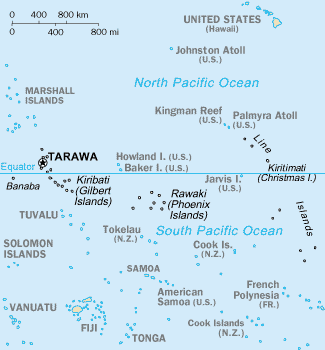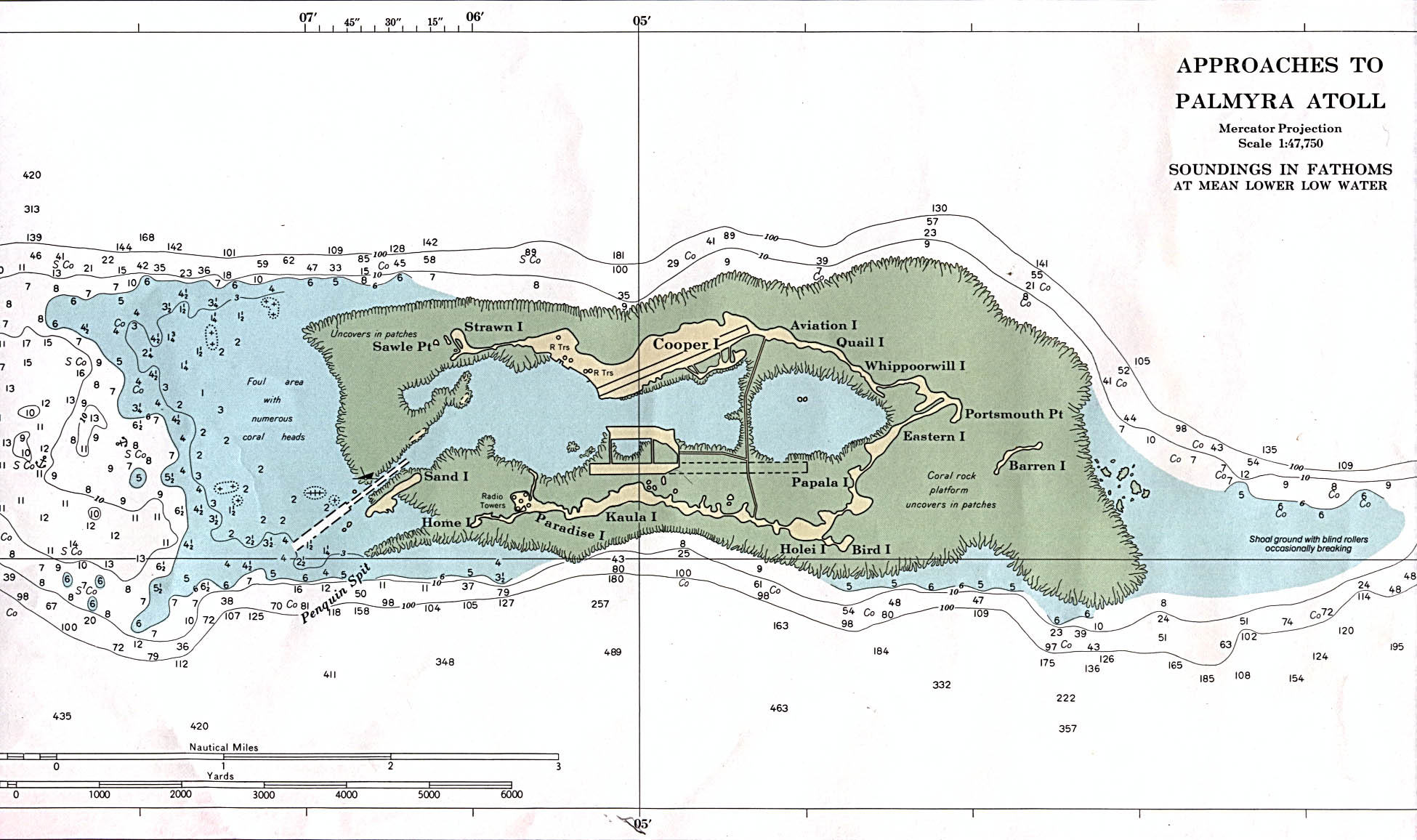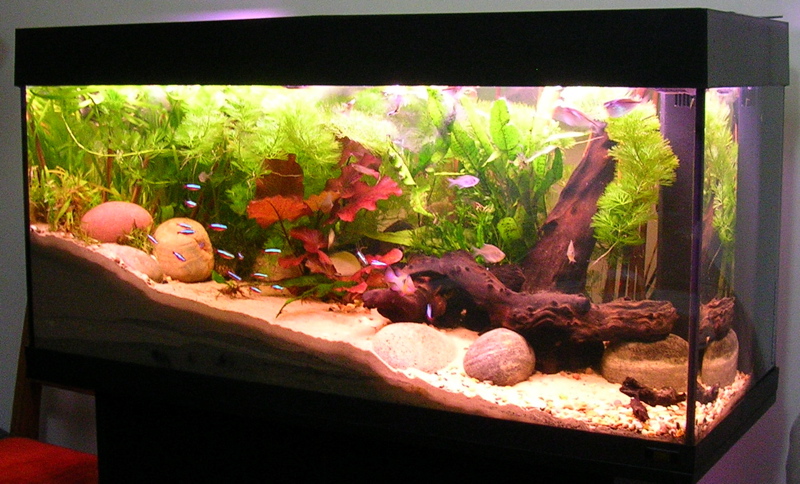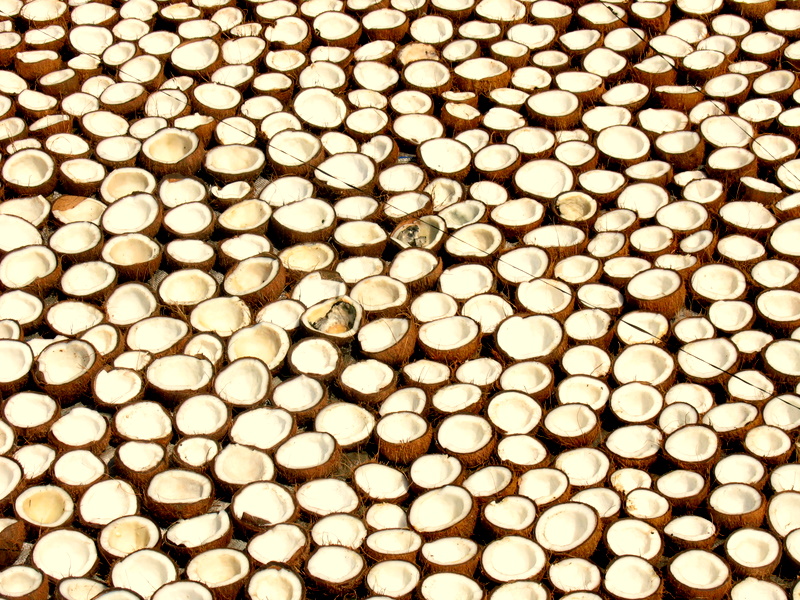|
Northern Line Islands
The Line Islands, Teraina Islands or Equatorial Islands (in Gilbertese language, Gilbertese, ''Aono Raina'') are a chain of 11 atolls (with partly or fully enclosed lagoons) and coral islands (with a surrounding reef) in the central Pacific Ocean, south of the Hawaiian Islands. The island chain stretches northwest to southeast across , making it one of the longest island chains in the world. It lies at the geographic center of the Pacific Ocean (), near Starbuck Island. One of the atolls in the group, Kiritimati, has the largest land area of any atoll in the world. Of the 11 atolls, all of which were formed by volcanic activity, only the Kiritimati and Tabuaeran atolls and Teraina island have a permanent population (one of the reefs, Filippo Reef, is shown on some maps, but its existence is doubted). Eight of the atolls are parts of Kiribati. The remaining three—Jarvis Island, Kingman Reef (which is largely submerged), and Palmyra Atoll—are territories of the United States gr ... [...More Info...] [...Related Items...] OR: [Wikipedia] [Google] [Baidu] |
Pacific Ocean
The Pacific Ocean is the largest and deepest of Earth's five oceanic divisions. It extends from the Arctic Ocean in the north to the Southern Ocean (or, depending on definition, to Antarctica) in the south, and is bounded by the continents of Asia and Oceania in the west and the Americas in the east. At in area (as defined with a southern Antarctic border), this largest division of the World Ocean—and, in turn, the hydrosphere—covers about 46% of Earth's water surface and about 32% of its total surface area, larger than Earth's entire land area combined .Pacific Ocean . '' Britannica Concise.'' 2008: Encyclopædia Britannica, Inc. The centers of both the |
Palmyra Atoll
Palmyra Atoll (), also referred to as Palmyra Island, is one of the Line Islands, Northern Line Islands (southeast of Kingman Reef and north of Kiribati). It is located almost due south of the Hawaiian Islands, roughly one-third of the way between Hawaii and American Samoa. North America is about northeast and New Zealand the same distance southwest, placing the atoll at the approximate center of the Pacific Ocean. The land area is , with about 9 miles (14 km) of sea-facing coastline and reef. There is one boat Anchorage (maritime), anchorage known as West Lagoon, accessible from the sea by a narrow artificial channel. It is the second-to-northernmost of the Line Islands, and one of three American islands in the archipelago, along with Jarvis Island and Kingman Reef. Palmyra Atoll is part of the Pacific Remote Islands Marine National Monument, the world's largest marine protected area. The atoll is composed of submerged sand flats along with dry land and reefs. It consis ... [...More Info...] [...Related Items...] OR: [Wikipedia] [Google] [Baidu] |
All Red Line
The All Red Line was a system of electrical telegraphs that linked much of the British Empire. It was inaugurated on 31 October 1902. The informal name derives from the common practice of colouring the territory of the British Empire red or pink on political maps. Construction The first transatlantic cable connected Ireland and Newfoundland in 1858, although it later failed. In 1866, the laid out a lasting link from Valentia Island, in Ireland, to Heart's Content, Newfoundland. By 1870, Suez was linked to Bombay, and from there to Madras, Penang, and Singapore. Australia was linked to British telegraph cables directly in 1871, by extending a line from Singapore to Port Darwin, although it ran through the Dutch territory of Java. By 1872, messages could be sent direct from London to Adelaide and Sydney. Australia was linked to New Zealand by cable in 1876. To complete the All Red Line, therefore, the final major cable laying project was the trans-Pacific section. A resol ... [...More Info...] [...Related Items...] OR: [Wikipedia] [Google] [Baidu] |
Whaling
Whaling is the process of hunting of whales for their usable products such as meat and blubber, which can be turned into a type of oil that became increasingly important in the Industrial Revolution. It was practiced as an organized industry as early as 875 AD. By the 16th century, it had risen to be the principal industry in the Basque coastal regions of Spain and France. The industry spread throughout the world, and became increasingly profitable in terms of trade and resources. Some regions of the world's oceans, along the animals' migration routes, had a particularly dense whale population, and became the targets for large concentrations of whaling ships, and the industry continued to grow well into the 20th century. The depletion of some whale species to near extinction led to the banning of whaling in many countries by 1969, and to an international cessation of whaling as an industry in the late 1980s. The earliest known forms of whaling date to at least 3000 BC. Coasta ... [...More Info...] [...Related Items...] OR: [Wikipedia] [Google] [Baidu] |
Marae
A ' (in New Zealand Māori, Cook Islands Māori, Tahitian), ' (in Tongan), ' (in Marquesan) or ' (in Samoan) is a communal or sacred place that serves religious and social purposes in Polynesian societies. In all these languages, the term also means cleared and free of weeds or trees. generally consist of an area of cleared land roughly rectangular (the itself), bordered with stones or wooden posts (called ' in Tahitian and Cook Islands Māori) perhaps with ' (terraces) which were traditionally used for ceremonial purposes; and in some cases, a central stone ' or ''a'u''. In the Rapa Nui culture of Easter Island, the term ' has become a synonym for the whole marae complex. In some modern Polynesian societies, notably that of the Māori of New Zealand, the marae is still a vital part of everyday life. In tropical Polynesia, most marae were destroyed or abandoned with the arrival of Christianity in the 19th century, and some have become an attraction for tourists or archaeol ... [...More Info...] [...Related Items...] OR: [Wikipedia] [Google] [Baidu] |
Map Of Kiribati CIA WFB
A map is a symbolic depiction emphasizing relationships between elements of some space, such as objects, regions, or themes. Many maps are static, fixed to paper or some other durable medium, while others are dynamic or interactive. Although most commonly used to depict geography, maps may represent any space, real or fictional, without regard to context or scale, such as in brain mapping, DNA mapping, or computer network topology mapping. The space being mapped may be two dimensional, such as the surface of the earth, three dimensional, such as the interior of the earth, or even more abstract spaces of any dimension, such as arise in modeling phenomena having many independent variables. Although the earliest maps known are of the heavens, geographic maps of territory have a very long tradition and exist from ancient times. The word "map" comes from the , wherein ''mappa'' meant 'napkin' or 'cloth' and ''mundi'' 'the world'. Thus, "map" became a shortened term referring to ... [...More Info...] [...Related Items...] OR: [Wikipedia] [Google] [Baidu] |
Fishkeeping
Fishkeeping is a popular hobby, practiced by aquarists, concerned with keeping fish in a home aquarium or garden pond. There is also a piscicultural fishkeeping industry, serving as a branch of agriculture. Origins of fishkeeping Fish have been raised as food in pools and ponds for thousands of years. Brightly colored or tame specimens of fish in these pools have sometimes been valued as pets rather than food. Many cultures, ancient and modern, have kept fish for both functional and decorative purposes. Ancient Sumerians kept wild-caught fish in ponds, before preparing them for meals. Depictions of the sacred fish of Oxyrhynchus kept in captivity in rectangular temple pools have been found in ancient Egyptian art. Similarly, Asia has experienced a long history of stocking rice paddies with freshwater fish suitable for eating, including various types of catfish and cyprinid. Selective breeding of carp into today's popular and completely domesticated koi and fancy goldfish b ... [...More Info...] [...Related Items...] OR: [Wikipedia] [Google] [Baidu] |
Copra
Copra (from ) is the dried, white flesh of the coconut from which coconut oil is extracted. Traditionally, the coconuts are sun-dried, especially for export, before the oil, also known as copra oil, is pressed out. The oil extracted from copra is rich in lauric acid, making it an important commodity in the preparation of lauryl alcohol, soaps, fatty acids, cosmetics, etc. and thus a lucrative product for many coconut-producing countries. The palatable oil cake, known as copra cake, obtained as a residue in the production of copra oil is used in animal feeds. The ground cake is known as coconut or copra meal. Production Copra has traditionally been grated and ground, then boiled in water to extract coconut oil. It was used by Pacific island cultures and became a valuable commercial product for merchants in the Polynesia, South Seas and South Asia in the 1860s. Nowadays, coconut oil (70%) is extracted by crushing copra; the by-product is known as copra cake or copra meal (30%) ... [...More Info...] [...Related Items...] OR: [Wikipedia] [Google] [Baidu] |
Baker Island
Baker Island, formerly known as New Nantucket, is an uninhabited atoll just north of the Equator in the central Pacific Ocean about southwest of Honolulu. The island lies almost halfway between Hawaii and Australia. Its nearest neighbor is Howland Island, to the north-northwest; both have been claimed as territories of the United States since 1857, though the United Kingdom considered them part of the British Empire between 1897 and 1936. The island covers , with of coastline. The climate is equatorial, with little rainfall, constant wind, and strong sunshine. The terrain is low-lying and sandy: a coral island surrounded by a narrow fringing reef with a depressed central area devoid of a lagoon with its highest point being above sea level. The island now forms the Baker Island National Wildlife Refuge and is an unincorporated and unorganized territory of the U.S. which vouches for its defense. It is visited annually by the U.S. Fish and Wildlife Service. For statistical p ... [...More Info...] [...Related Items...] OR: [Wikipedia] [Google] [Baidu] |
Oceania
Oceania (, , ) is a region, geographical region that includes Australasia, Melanesia, Micronesia, and Polynesia. Spanning the Eastern Hemisphere, Eastern and Western Hemisphere, Western hemispheres, Oceania is estimated to have a land area of and a population of around 44.5 million as of 2021. When compared with (and sometimes described as being one of) the continents, the region of Oceania is the smallest in land area and the list of continents and continental subregions by population, second least populated after Antarctica. Its major population centres are Sydney, Melbourne, Brisbane, Perth, Auckland, Adelaide, Honolulu, and Christchurch. Oceania has a diverse mix of economies from the developed country, highly developed and globally competitive market economy, financial markets of Australia, French Polynesia, Hawaii, Hawaii, New Caledonia, and New Zealand, which rank high in quality of life and Human Development Index, to the much least developed countries, less developed ... [...More Info...] [...Related Items...] OR: [Wikipedia] [Google] [Baidu] |
Hawaii
Hawaii ( ; haw, Hawaii or ) is a state in the Western United States, located in the Pacific Ocean about from the U.S. mainland. It is the only U.S. state outside North America, the only state that is an archipelago, and the only state geographically located within the tropics. Hawaii comprises nearly the entire Hawaiian archipelago, 137 volcanic islands spanning that are physiographically and ethnologically part of the Polynesian subregion of Oceania. The state's ocean coastline is consequently the fourth-longest in the U.S., at about . The eight main islands, from northwest to southeast, are Niihau, Kauai, Oahu, Molokai, Lānai, Kahoolawe, Maui, and Hawaii—the last of these, after which the state is named, is often called the "Big Island" or "Hawaii Island" to avoid confusion with the state or archipelago. The uninhabited Northwestern Hawaiian Islands make up most of the Papahānaumokuākea Marine National Monument, the United States' largest protected ... [...More Info...] [...Related Items...] OR: [Wikipedia] [Google] [Baidu] |
Time Zone
A time zone is an area which observes a uniform standard time for legal, Commerce, commercial and social purposes. Time zones tend to follow the boundaries between Country, countries and their Administrative division, subdivisions instead of strictly following longitude, because it is convenient for areas in frequent communication to keep the same time. All time zones are defined as offsets from Coordinated Universal Time (UTC), ranging from UTC−12:00 to UTC+14:00. The UTC offset, offsets are usually a whole number of hours, but a few zones are offset by an additional 30 or 45 minutes, such as in Indian Standard Time, India, Time in Australia, South Australia and Nepal Time, Nepal. Some areas of higher latitude use daylight saving time for about half of the year, typically by adding one hour to local time during spring (season), spring and summer. List of UTC offsets In the table below, the locations that use daylight saving time (DST) are listed in their UTC offse ... [...More Info...] [...Related Items...] OR: [Wikipedia] [Google] [Baidu] |

.jpg)








